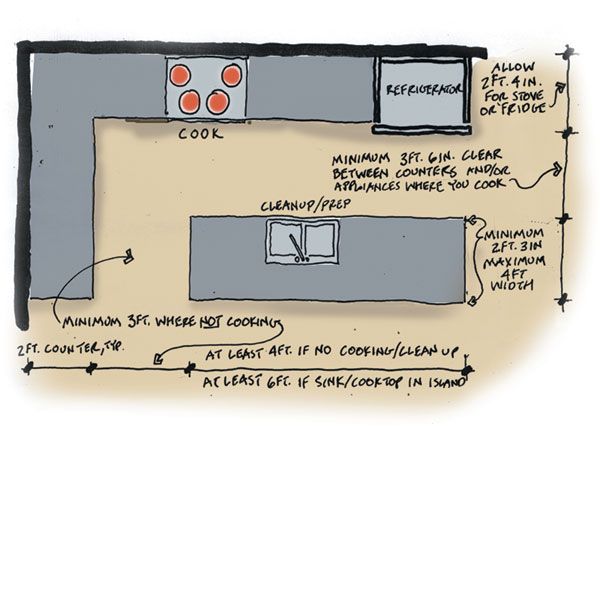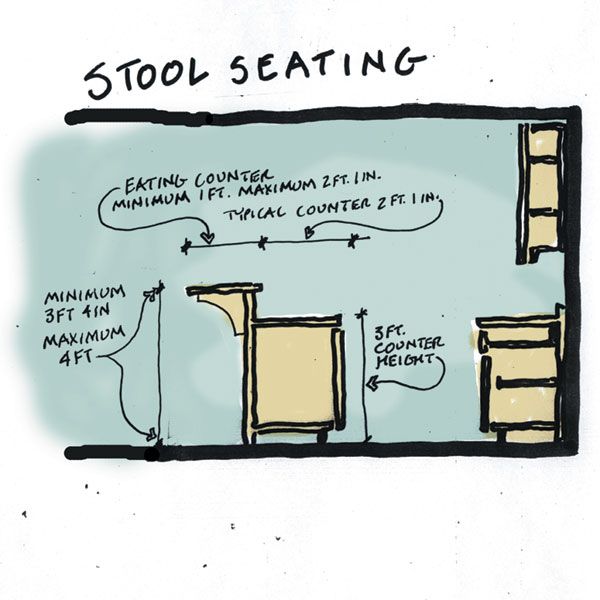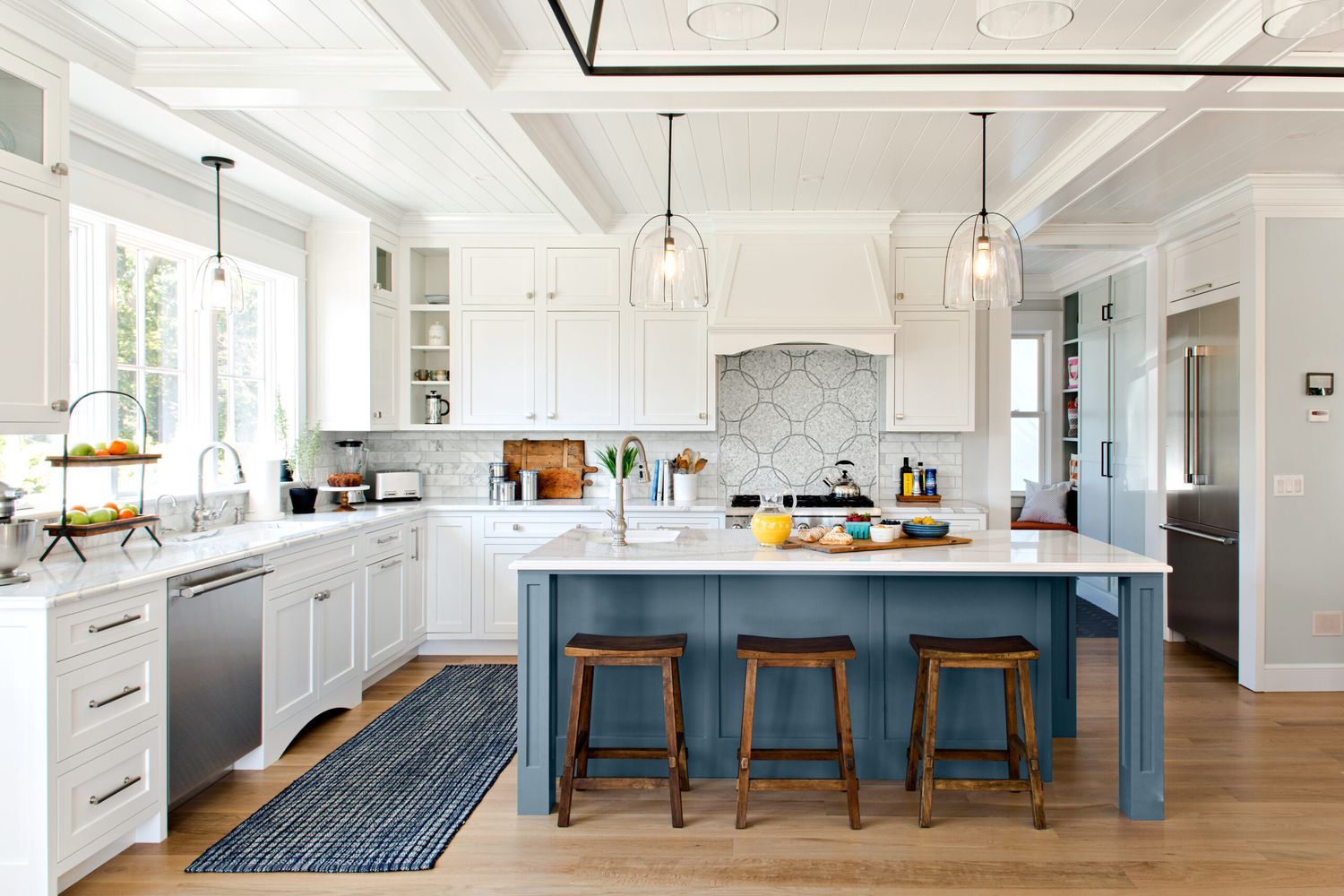Islands have become a vital part of the modern kitchen, the 21st-century equivalent of a hearth. Since they can be accessed from all sides, they’re ideal for a variety of tasks, not all of which involve cooking.
There are island designs that give multiple cooks the space they need to work efficiently, your guests the space they need to socialize, and your kids a great space to do homework. The best part is that they’re all relatively easy to add if you renovate your kitchen. Follow our professional tips to build an island that fits your design tastes and functional preferences.
Uses for a Kitchen Island
Islands can take up quite a bit of space, so you should design yours to justify that large footprint. Here are a few things to keep in mind for each use.
Cleanup
If your island will primarily serve as a cleanup station, consider the following:
- Ensure ample clearance for the dishwasher to open and close.
- Hide garbage and compost bins elegantly by installing pull-out drawers near the sink.
- Place dish and silverware storage within easy reach.
- Include storage for cleaning supplies and dish towels.
- If you want to hide dirty dishes from view of your guests, a dual-height counter can help.
Food Prep Space
If you see yourself preparing smorgasbords and feasts at your kitchen island, don’t forget to include these components:
- Multiple power outlets for small appliances
- Small refrigerator drawers or a wine cooler
- Easy access to compost bins, trash cans, and garbage disposals
- A prep sink with butcher block countertops
- Storage for cutting boards and your most frequently used utensils
Cooking
The prep is only one part of making a meal. If you enjoy cooking, remember to include these items so everything’s within reach:
- Heat-resistant stone, tile, and metal countertops for hot pans
- At least 18 inches of space on either side of the cooktop or range
- An overhead vent hood or downdraft fan, with a secondary exhaust fan in the ceiling
- A raised eating area out of the range of splatters
Informal Dining
An island can be a great space for casual eating, whether it’s just your family or a big party. Follow these tips to design a great dining island:
- Design the counter height and width to accommodate standard-size chairs or stools.
- Choose a softly contoured edge profile for comfort when leaning on the counter.
- Include storage for placemats, napkins, and other dining essentials.
- Add a slight overhang to give sitting guests much-needed legroom.
Considerations When Building a Kitchen Island
Kitchen islands come in many shapes and sizes, with plenty of opportunities for customization. Here are some things to keep in mind when building your kitchen island.

Size and Placement
Shoehorning an island into a kitchen that’s too small is not a good idea. At a minimum, an island should be 4 feet long and slightly more than 2 feet deep. It should also have room for people to move and work around it. In spaces where you’re not cooking, 3 feet is the minimum recommended clearance between islands and cabinets. You should also have at least 3 1/2 feet clear between counters or cooking appliances.
Remember that these dimensions are just minimums. If your floor plan allows, you should be more generous.
Lighting
You can’t count on ambient light to illuminate your workspaces, so dedicated lighting is recommended for islands. Since islands don’t have cabinets over them to hide task lights, plan for dedicated ceiling-mounted fixtures. Recessed lights are the most common choice, which is easy if you have standard-height ceilings. If your kitchen has a high ceiling over 6 feet tall, you may need to use bulbs that project light down instead of spreading it outward.
Pendant fixtures are another popular lighting option, especially for high ceilings. However, you’ll need to find ones with the right height profile, about 30–36 inches above the countertop in many cases. If the pendants are too high or too low, they’ll either block your view from the island or shine high-intensity light straight into your eyes.
Whatever lighting type you choose, we recommend installing dimmer switches. This will let you adjust the brightness according to different activities and the time of day. If you’re not cooking, you may not need the lights on full brightness.
Storage Space
There’s never enough storage space in kitchens, and you can gain valuable real estate for the purpose on both the island’s working and “public” sides.
On the public side, install shallow cabinets back-to-back for napkins, cutlery, platters, and serving supplies that don’t need to be in the food prep area. On the working side, add enough storage for pots, pans, and spices. The space under cooktops is great for deep drawers. Think twice about installing a hanging pot rack, however—it won’t hold deeper pots or lids and can get in the way of your view.
If you’re building a prep island, include storage for knives and small appliances like mixers and food processors. For these, try appliance garages or pop-ups—platforms that swing out from behind a door in the island base. Make sure there is also convenient access to garbage and compost bins. If the island will be dedicated to cleanup, you’ll need a place for dish towels, detergent, and brushes.
Undercounter storage space is limited on islands with a sink or major appliances. The same applies to cooktops with downdraft fans, which require the machinery to be stored in the cabinet underneath. One way around this is to use the ends of the island. Round ends are perfect for lazy Susans and almost any island end can accommodate open shelving or a shallow cabinet.
Vent Hood
Ventilation is a safety essential, and it also stops nasty cooking odors from permeating your home. Downdraft fans beneath a cooktop are a popular addition that doesn’t impact visibility. However, they aren’t sufficient for handling strong odors and excessive steam. If you really want to clear the air, include a second exhaust fan mounted on the ceiling. This will also help limit how much moisture condenses inside your windows in the wintertime.
Another option is an overhead hood that extends through the ceiling. Because it’s exposed on all sides, it becomes a dominant design element in your kitchen, and you’ll need to completely finish it—which can get expensive. You can opt for manufactured versions or order a custom-built hood in just about any material. Just be aware that the hood’s mass, placed low enough to be effective, could ruin the joy of having open space above the island.
Counter Height
Dual-height islands can create informal eating areas, hide dirty dishes, protect noncooks from splashes and splatters, and make kitchens more interesting. You can make an island “disappear” to anyone not working in the kitchen by extending the “public” face of the island—the one that doesn’t face the kitchen—4 to 6 inches above the countertop and covering it in the same surface material as the rest of the interior walls.

The height of your island’s eating area dictates the type of seating you’ll have. A 28- to 30-inch-high counter works best with a chair, a standard-height 36-inch counter is best served by a low stool, and a 42- to 48-inch counter requires a bar stool.
Plumbing and Electrical Considerations for Kitchen Islands
If you’re incorporating sinks or appliances into your island, make sure there’s enough space for the necessary plumbing, electrical wiring, and ductwork. Consult licensed professionals to confirm all the installations comply with local codes and standards.
Seating Arrangements
Comfortable seating is vital if you plan to use your kitchen island for dining or socializing. Consider the number of seats you need, what design style best fits your kitchen, and what arrangement will let you sit comfortably without feeling cramped. Stools are a common choice and come in various styles to match different decors. Designs with footrests and back supports might be more comfortable for your family and guests.
Resource
Architect
Duo Dickinson
Madison, CT
203-245-0405
duodickinson.com

